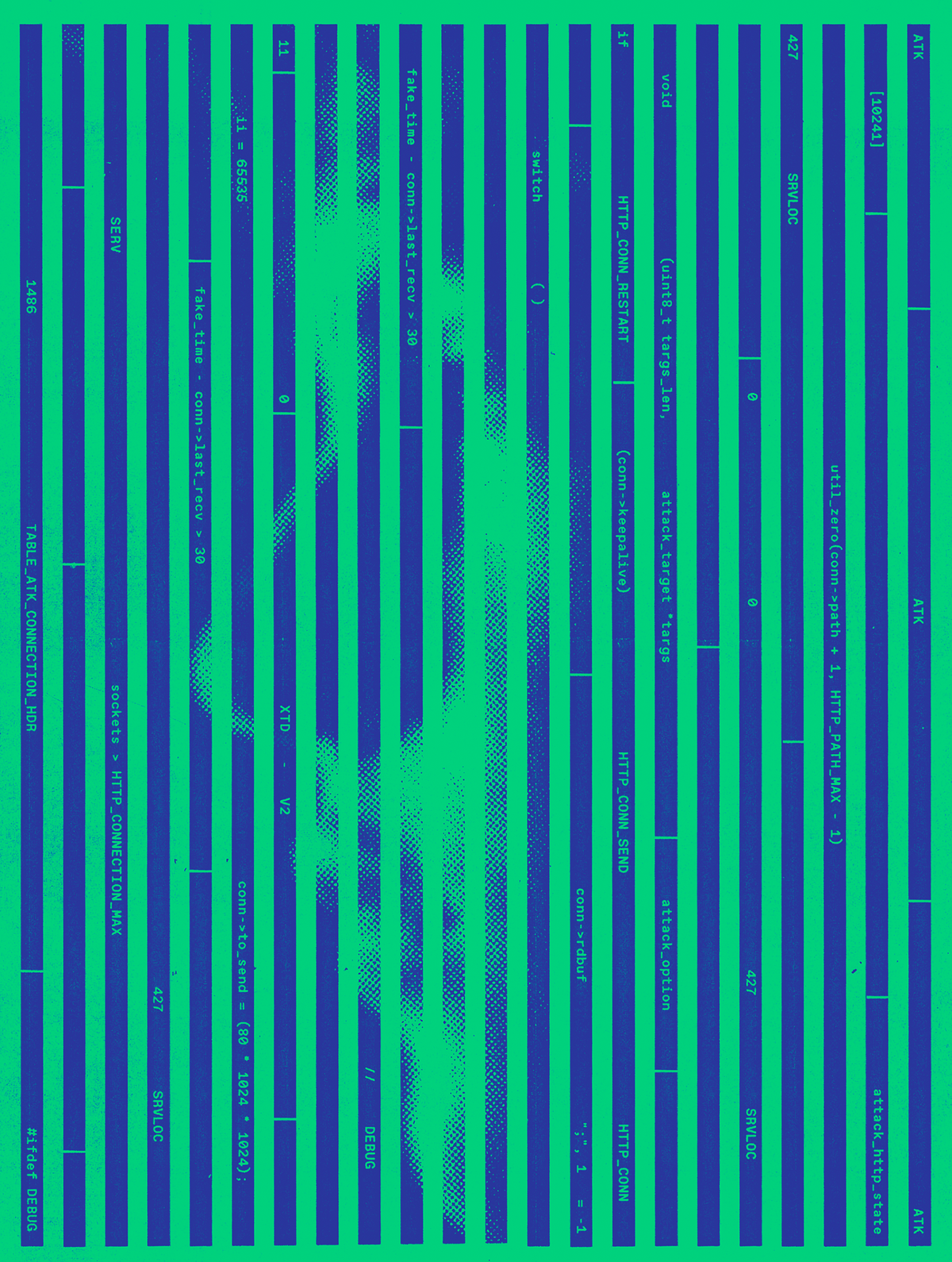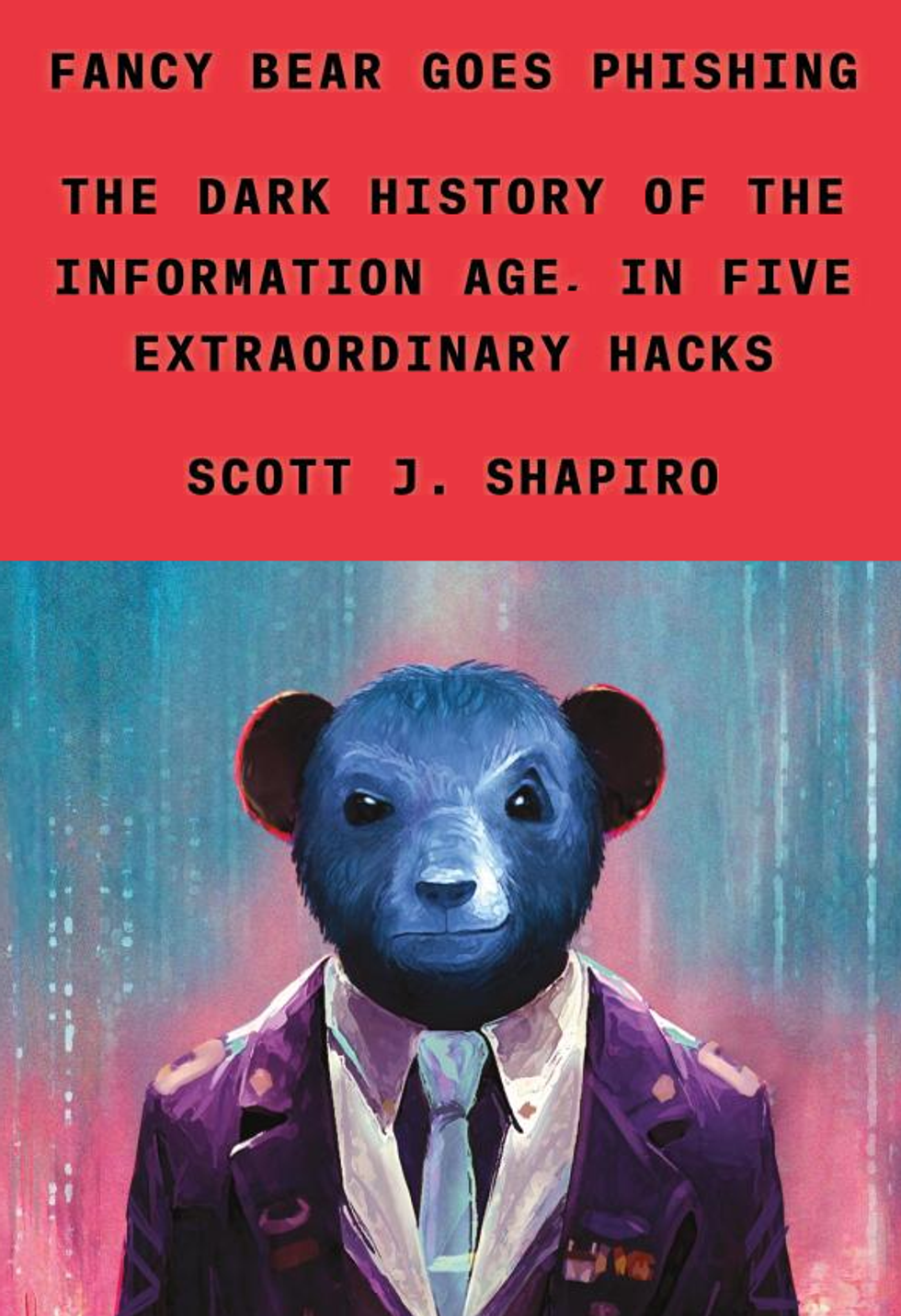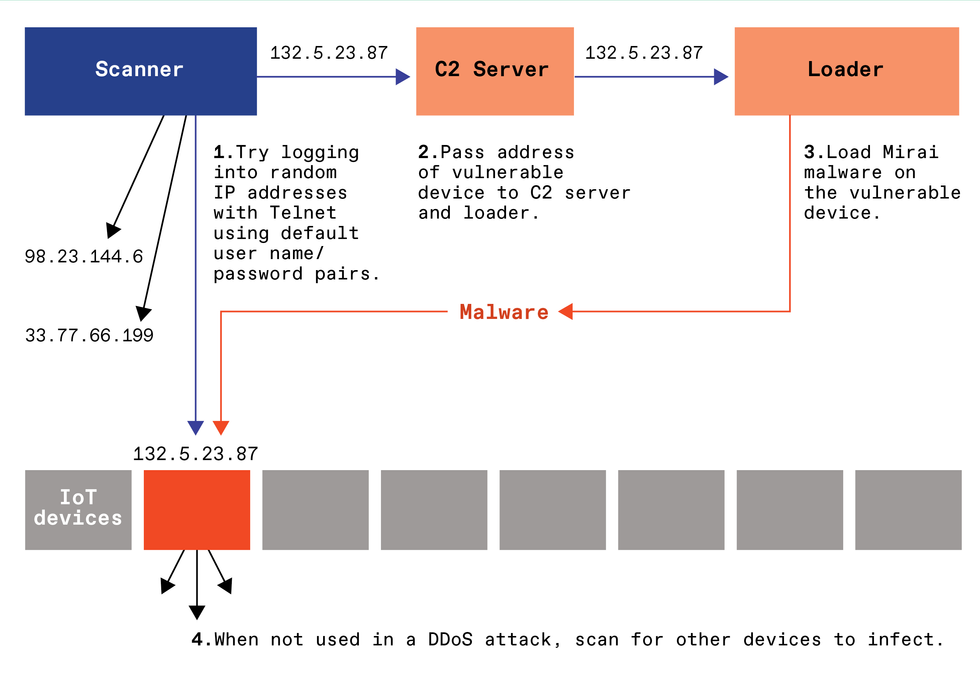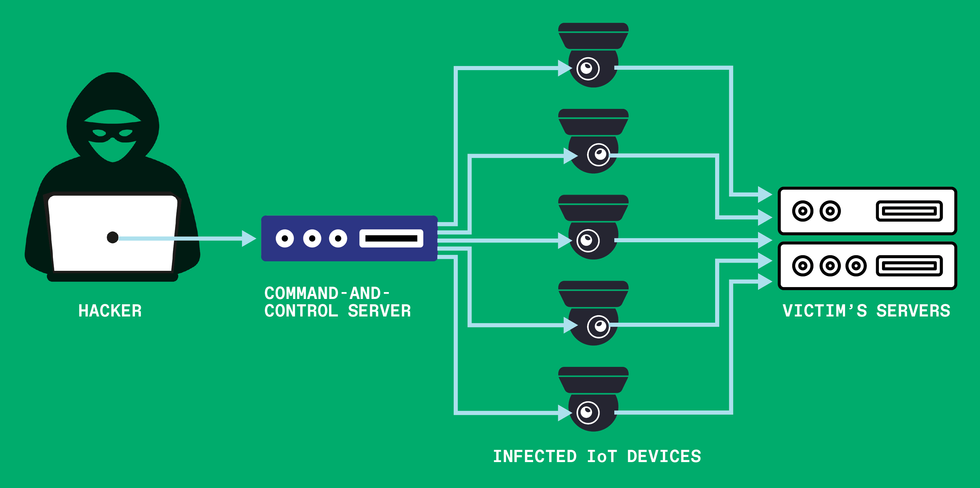The Strange Story of the Teens Behind the Mirai Botnet
Their DDoS malware threatened the entire Internet

First-year college students are understandably frustrated when they can’t get into popular upper-level electives. But they usually just gripe. Paras Jha was an exception. Enraged that upper-class students were given priority to enroll in a computer-science elective at Rutgers, the State University of New Jersey, Paras decided to crash the registration website so that no one could enroll.
On Wednesday night, 19 November 2014, at 10:00 p.m. EST—as the registration period for first-year students in spring courses had just opened—Paras launched his first distributed denial-of-service (DDoS) attack. He had assembled an army of some 40,000 bots, primarily in Eastern Europe and China, and unleashed them on the Rutgers central authentication server. The botnet sent thousands of fraudulent requests to authenticate, overloading the server. Paras’s classmates could not get through to register.
The next semester Paras tried again. On 4 March 2015, he sent an email to the campus newspaper, The Daily Targum: “A while back you had an article that talked about the DDoS attacks on Rutgers. I’m the one who attacked the network.… I will be attacking the network once again at 8:15 pm EST.” Paras followed through on his threat, knocking the Rutgers network offline at precisely 8:15 p.m.

This article was adapted from the author’s new book, Fancy Bear Goes Phishing: The Dark History of the Information Age, in Five Extraordinary Hacks (Farrar, Straus, and Giroux 2023).
On 27 March, Paras unleashed another assault on Rutgers. This attack lasted four days and brought campus life to a standstill. Fifty thousand students, faculty, and staff had no computer access from campus.
On 29 April, Paras posted a message on Pastebin, a website popular with hackers for sending anonymous messages. “The Rutgers IT department is a joke,” he taunted. “This is the third time I have launched DDoS attacks against Rutgers, and every single time, the Rutgers infrastructure crumpled like a tin can under the heel of my boot.”
Paras was furious that Rutgers chose Incapsula, a small cybersecurity firm based in Massachusetts, as its DDoS-mitigation provider. He claimed that Rutgers chose the cheapest company. “Just to show you the poor quality of Incapsula’s network, I have gone ahead and decimated the Rutgers network (and parts of Incapsula), in the hopes that you will pick another provider that knows what they are doing.”
Paras’s fourth attack on the Rutgers network, taking place during finals, caused chaos and panic on campus. Paras reveled in his ability to shut down a major state university, but his ultimate objective was to force it to abandon Incapsula. Paras had started his own DDoS-mitigation service, ProTraf Solutions, and wanted Rutgers to pick ProTraf over Incapsula. And he wasn’t going to stop attacking his school until it switched.
A Hacker Forged in Minecraft
Paras Jha was born and raised in Fanwood, a leafy suburb in central New Jersey. When Paras was in the third grade, a teacher recommended that he be evaluated for attention deficit hyperactivity disorder, but his parents didn’t follow through.
As Paras progressed through elementary school, his struggles increased. Because he was so obviously intelligent, his teachers and parents attributed his lackluster performance to laziness and apathy. His perplexed parents pushed him even harder.
Paras sought refuge in computers. He taught himself how to code when he was 12 and was hooked. His parents happily indulged this passion, buying him a computer and providing him with unrestricted Internet access. But their indulgence led Paras to isolate himself further, as he spent all his time coding, gaming, and hanging out with his online friends.
Paras was particularly drawn to the online game Minecraft. In ninth grade, he graduated from playing Minecraft to hosting servers. It was in hosting game servers that he first encountered DDoS attacks.
Minecraft server administrators often hire DDoS services to knock rivals offline. As Paras learned more sophisticated DDoS attacks, he also studied DDoS defense. As he became proficient in mitigating attacks on Minecraft servers, he decided to create ProTraf Solutions.
Paras’s obsession with Minecraft attacks and defense, compounded by his untreated ADHD, led to an even greater retreat from family and school. His poor academic performance in high school frustrated and depressed him. His only solace was Japanese anime and the admiration he gained from the online community of Minecraft DDoS experts.
Paras’s struggles deteriorated into paralysis when he enrolled in Rutgers, studying for a B.S. in computer science. Without his mother’s help, he was unable to regulate the normal demands of living on his own. He could not manage his sleep, schedule, or study. Paras was also acutely lonely. So he immersed himself in hacking.
Paras and two hacker friends, Josiah White and Dalton Norman, decided to go after the kings of DDoS—a gang known as VDoS. The gang had been providing these services to the world for four years, which is an eternity in cybercrime. The decision to fight experienced cybercriminals may seem brave, but the trio were actually older than their rivals. The VDoS gang members had been only 14 years old when they started to offer DDoS services from Israel in 2012. These 19-year-old American teenagers would be going to battle against two 18-year-old Israeli teenagers. The war between the two teenage gangs would not only change the nature of malware. Their struggle for dominance in cyberspace would create a doomsday machine.
Bots for Tots - Here’s how three teenagers built a botnet that could take down the Internet

IEEE Spectrum
The Mirai botnet, with all its devastating potential, was not the product of an organized-crime or nation-state hacking group—it was put together by three teenage boys. They rented out their botnet to paying customers to do mischief with and used it to attack chosen targets of their own. But the full extent of the danger became apparent only later, after this team made the source code for their malware public. Then others used it to do greater harm: crashing Germany’s largest Internet service provider; attacking Dyn’s Domain Name System servers, making the Internet unusable for millions; and taking down all of Liberia’s Internet—to name a few examples.
The Mirai botnet exploited vulnerable Internet of Things devices, such as Web-connected video cameras, ones that supported Telnet, an outdated system for logging in remotely. Owners of these devices rarely updated their passwords, so they could be easily guessed using a strategy called a dictionary attack.
The first step in assembling a botnet was to scan random IP addresses looking for vulnerable IoT devices, ones whose passwords could be guessed. Once identified, the addresses of these devices were passed to a “loader,” which would put the malware on the vulnerable device. Infected devices located all over the world could then be used for distributed denial-of-service attacks, orchestrated by a command-and-control (C2) server. When not attacking a target, these bots would be enlisted to scan for more vulnerable devices to infect.
Botnet Madness
Botnet malware is useful for financially motivated crime because botmasters can tell the bots in their thrall to implant malware on vulnerable machines, send phishing emails, or engage in click fraud, in which botnets profit by directing bots to click pay-per-click ads. Botnets are also great DDoS weapons because they can be trained on a target and barrage it from all directions. One day in February 2000, for example, the hacker MafiaBoy knocked out Fifa.com, Amazon.com, Dell, E-Trade, eBay, CNN, as well as Yahoo, at the time the largest search engine on the Internet.
After taking so many major websites offline, MafiaBoy was deemed a national -security threat. President Clinton ordered a national manhunt to find him. In April 2000, MafiaBoy was arrested and charged, and in January 2001 he pled guilty to 58 charges of denial-of-service attacks. Law enforcement did not reveal MafiaBoy’s real name, as this national-security threat was 15 years old.
Both MafiaBoy and the VDoS crew were adolescent boys who crashed servers. But whereas MafiaBoy did it for the sport, VDoS did it for the money. Indeed, these teenage Israeli kids were pioneering tech entrepreneurs. They helped launch a new form of cybercrime: DDoS as a service. With it, anyone could now hack with the click of a button, no technical knowledge needed.
It might be surprising that DDoS providers could advertise openly on the Web. After all, DDoSing another website is illegal everywhere. To get around this, these “booter services” have long argued they perform a legitimate function: providing those who set up Web pages a means to stress test websites.
In theory, such services do play an important function. But only in theory. As a booter-service provider admitted to University of Cambridge researchers, “We do try to market these services towards a more legitimate user base, but we know where the money comes from.”
The Botnets of August
Paras dropped out of Rutgers in his sophomore year and, with his father’s encouragement, spent the next year focused on building ProTraf Solutions, his DDoS-mitigation business. And just like a mafia don running a protection racket, he had to make that protection needed. After launching four DDoS attacks his freshman year, he attacked Rutgers yet again in September 2015, still hoping that his former school would give up on Incapsula. Rutgers refused to budge.
ProTraf Solutions was failing, and Paras needed cash. In May 2016, Paras reached out to Josiah White. Like Paras, Josiah frequented Hack Forums. When he was 15, he developed major portions of Qbot, a botnet worm that at its height in 2014 had enslaved half a million computers. Now 18, Josiah switched sides and worked with his friend Paras at ProTraf doing DDoS mitigation.

But Josiah soon returned to hacking and started working with Paras to take the Qbot malware, improve it, and build a bigger, more powerful DDoS botnet. Paras and Josiah then partnered with 19-year-old Dalton Norman. The trio turned into a well-oiled team: Dalton found the vulnerabilities; Josiah updated the botnet malware to exploit these vulnerabilities; and Paras wrote the C2—software for the command-and-control server—for controlling the botnet.
But the trio had competition. Two other DDoS gangs—Lizard Squad and VDoS—decided to band together to build a giant botnet. The collaboration, known as PoodleCorp, was successful. The amount of traffic that could be unleashed on a target from PoodleCorp’s botnet hit a record value of 400 gigabits per second, almost four times the rate that any previous botnet had achieved. They used their new weapon to attack banks in Brazil, U.S. government sites, and Minecraft servers. They achieved this firepower by hijacking 1,300 Web-connected cameras. Web cameras tend to have powerful processors and good connectivity, and they are rarely patched. So a botnet that harnesses video has enormous cannons at its disposal.
While PoodleCorp was on the rise, Paras, Josiah, and Dalton worked on a new weapon. By the beginning of August 2016, the trio had completed the first version of their botnet malware. Paras called the new code Mirai, after the anime series Mirai Nikki.
When Mirai was released, it spread like wildfire. In its first 20 hours, it infected 65,000 devices, doubling in size every 76 minutes. And Mirai had an unwitting ally in the botnet war then raging.
Up in Anchorage, Alaska, the FBI cyber unit was building a case against VDoS. The FBI was unaware of Mirai or its war with VDoS. The agents did not regularly read online boards such as Hack Forums. They did not know that the target of their investigation was being decimated. The FBI also did not realize that Mirai was ready to step into the void.
The head investigator in Anchorage was Special Agent Elliott Peterson. A former U.S. Marine, Peterson is a calm and self-assured agent with a buzz cut of red hair. At the age of 33, Peterson had returned to his native state of Alaska to prosecute cybercrime.
On 8 September 2016, the FBI’s Anchorage and New Haven cyber units teamed up and served a search warrant in Connecticut on the member of PoodleCorp who ran the C2 that controlled all its botnets. On the same day, the Israeli police arrested the VDoS founders in Israel. Suddenly, PoodleCorp was no more.
The Mirai group waited a couple of days to assess the battlefield. As far as they could tell, they were the only botnet left standing. And they were ready to use their new power. Mirai won the war because Israeli and American law enforcement arrested the masterminds behind PoodleCorp. But Mirai would have triumphed anyway, as it was ruthlessly efficient in taking control of Internet of Things devices and excluding competing malware.
A few weeks after the arrests of those behind VDoS, Special Agent Peterson found his next target: the Mirai botnet. In the Mirai case, we do not know the exact steps that Peterson’s team took in their investigation: Court orders in this case are currently “under seal,” meaning that the court deems them secret. But from public reporting, we know that Peterson’s team got its break in the usual way—from a Mirai victim: Brian Krebs, a cybersecurity reporter whose blog was DDoSed by the Mirai botnet on 25 September.
The FBI uncovered the IP address of the C2 and loading servers but did not know who had opened the accounts. Peterson’s team likely subpoenaed the hosting companies to learn the names, emails, cellphones, and payment methods of the account holders. With this information, it would seek court orders and then search warrants to acquire the content of the conspirators’ conversations.
Still, the hunt for the authors of the Mirai malware must have been a difficult one, given how clever these hackers were. For example, to evade detection Josiah didn’t just use a VPN. He hacked the home computer of a teenage boy in France and used his computer as the “exit node.” The orders for the botnet, therefore, came from this computer. Unfortunately for the owner, he was a big fan of Japanese anime and thus fit the profile of the hacker. The FBI and the French police discovered their mistake after they raided the boy’s house.
Done and Done For
After wielding its power for two months, Paras dumped nearly the complete source code for Mirai on Hack Forums. “I made my money, there’s lots of eyes looking at IOT now, so it’s time to GTFO [Get The F*** Out],” Paras wrote. With that code dump, Paras had enabled anyone to build their own Mirai. And they did.
Dumping code is reckless, but not unusual. If the police find source code on a hacker’s devices, they can claim that they “downloaded it from the Internet.” Paras’s irresponsible disclosure was part of a false-flag operation meant to throw off the FBI, which had been gathering evidence indicating Paras’s involvement in Mirai and had contacted him to ask questions. Though he gave the agent a fabricated story, getting a text from the FBI probably terrified him.
Mirai had captured the attention of the cybersecurity community and of law enforcement. But not until after Mirai’s source code dropped would it capture the attention of the entire United States. The first attack after the dump was on 21 October, on Dyn, a company based in Manchester, N.H., that provides Domain Name System (DNS) resolution services for much of the East Coast of the United States.
Mike McQuade
It began at 7:07 a.m. EST with a series of 25-second attacks, thought to be tests of the botnet and Dyn’s infrastructure. Then came the sustained assaults: of one hour, and then five hours. Interestingly, Dyn was not the only target. Sony’s PlayStation video infrastructure was also hit. Because the torrents were so immense, many other websites were affected. Domains such as cnn.com, facebook.com, and nytimes.com wouldn’t work. For the vast majority of these users, the Internet became unusable. At 7:00 p.m., another 10-hour salvo hit Dyn and PlayStation.
Further investigations confirmed the point of the attack. Along with Dyn and PlayStation traffic, the botnet targeted Xbox Live and Nuclear Fallout game-hosting servers. Nation-states were not aiming to hack the upcoming U.S. elections. Someone was trying to boot players off their game servers. Once again—just like MafiaBoy, VDoS, Paras, Dalton, and Josiah—the attacker was a teenage boy, this time a 15-year-old in Northern Ireland named Aaron Sterritt.
Meanwhile, the Mirai trio left the DDoS business, just as Paras said. But Paras and Dalton did not give up on cybercrime. They just took up click fraud.
Click fraud was more lucrative than running a booter service. While Mirai was no longer as big as it had been, the botnet could nevertheless generate significant advertising revenue. Paras and Dalton earned as much money in one month from click fraud as they ever made with DDoS. By January 2017, they had earned over US $180,000, as opposed to a mere $14,000 from DDoSing.
Had Paras and his friends simply shut down their booter service and moved on to click fraud, the world would likely have forgotten about them. But by releasing the Mirai code, Paras created imitators. Dyn was the first major copycat attack, but many others followed. And due to the enormous damage these imitators wrought, law enforcement was intensely interested in the Mirai authors.
After collecting information tying Paras, Josiah, and Dalton to Mirai, the FBI quietly brought each up to Alaska. Peterson’s team showed the suspects its evidence and gave them the chance to cooperate. Given that the evidence was irrefutable, each folded.
Paras Jha was indicted twice, once in New Jersey for his attack on Rutgers, and once in Alaska for Mirai. Both indictments carried the same charge—one violation of the Computer Fraud and Abuse Act. Paras faced up to 10 years in federal prison for his actions. Josiah and Dalton were only indicted in Alaska and so faced 5 years in prison.
The trio pled guilty. At the sentencing hearing held on 18 September 2018, in Anchorage, each of the defendants expressed remorse for his actions. Josiah White’s lawyer conveyed his client’s realization that Mirai was “a tremendous lapse in judgment.”
Unlike Josiah, Paras spoke directly to Judge Timothy Burgess in the courtroom. Paras began by accepting full responsibility for his actions and expressed his deep regret for the trouble he’d caused his family. He also apologized for the harm he’d caused businesses and, in particular, Rutgers, the faculty, and his fellow students.
The Department of Justice made the unusual decision not to ask for jail time. In its sentencing memo, the government noted “the divide between [the defendants’] online personas, where they were significant, well-known, and malicious actors in the DDoS criminal milieu and their comparatively mundane ‘real lives’ where they present as socially immature young men living with their parents in relative obscurity.” It recommended five years of probation and 2,500 hours of community service.
The government had one more request —for that community service “to include continued work with the FBI on cybercrime and cybersecurity matters.” Even before sentencing, Paras, Josiah, and Dalton had logged close to 1,000 hours helping the FBI hunt and shut down Mirai copycats. They contributed to more than a dozen law enforcement and research efforts. In one instance, the trio assisted in stopping a nation-state hacking group. They also helped the FBI prevent DDoS attacks aimed at disrupting Christmas-holiday shopping. Judge Burgess accepted the government’s recommendation, and the trio escaped jail time.
The most poignant moments in the hearing were Paras’s and Dalton’s singling out for praise the very person who caught them. “Two years ago, when I first met Special Agent Elliott Peterson,” Paras told the court, “I was an arrogant fool believing that somehow I was untouchable. When I met him in person for the second time, he told me something I will never forget: ‘You’re in a hole right now. It’s time you stop digging.’ ” Paras finished his remarks by thanking “my family, my friends, and Agent Peterson for helping me through this.”
This article appears in the June 2023 print issue as “PatchMeifYouCan.”
- Building a Zero Trust Security Model for Autonomous Systems ›
- The Security Challenges of Online Voting Have Not Gone Away ›
- U.S. Congress Finally Gets Some Good Ideas About IoT Security ›


